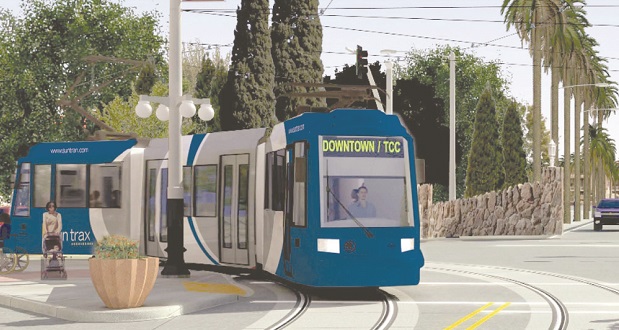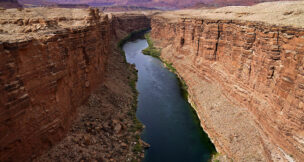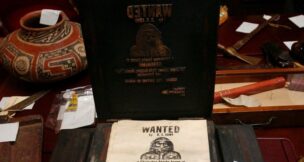From Streetcar to Sky Train: Arizona Environmental Awards
Arizona Capitol Times Staff//September 18, 2015//[read_meter]
From Streetcar to Sky Train: Arizona Environmental Awards
Arizona Capitol Times Staff//September 18, 2015//[read_meter]

What: Arizona Forward announced the winners of its 35th Annual Environmental Excellence Awards on Sept. 12 at Chateau Luxe in Phoenix in partnership with Salt River Project.
How many awards were there: Arizona Forward and SRP presented 17 first-place Crescordia awards and 31 Awards of Merit.
Top winner: The Sun Link Tucson Streetcar earned the President’s Award (Best of Show). Jurors selected the $196 million project “because the iconic project is vital to improving the look and feel of downtown Tucson while providing a much-needed boost to the community’s infrastructure.” The streetcar runs on a 4-mile line through the city’s largest activity centers, linking more than 100,000 people who live in the area.
Other notable winners:
Governor’s Award for Arizona’s Future: TEAM ARIZONA COLORADO RIVER SHORTAGE AND DROUGHT PREPAREDNESS (City of Phoenix/Central Arizona Water Conservation District/ADWR Partnership)
In response to dwindling supplies, Arizonans are forming strategic alliances and innovative water management strategies toward ensuring an adequate, safe and sustainable supply. Water providers and planners have stored nearly 3.4-million acre-feet of Colorado River water underground; partnered to store Central Arizona Project water in Tucson aquifers; aligned with irrigation districts in central Arizona and other partners to conserve and store water in Lake Mead; provided $5 million to help fund the pilot Colorado River System Conservation Program; and established the Northern Arizona Forest Fund to protect the state’s watersheds. These collaborative efforts have significantly increased the resiliency of Arizona’s water supplies.
Healthy Communities (Sustainable Communities): DOWNTOWN TOLLESON REDEVELOPMENT PROJECT: PASEO DE LUCES (J2 Engineering and Environmental Design)
The Downtown Tolleson Redevelopment Project was a 1-mile urban revitalization effort that set out to create a true sense of place for the city of Tolleson. It reflects the city’s history, culture and spirit while integrating sustainable design principles.
Healthy Communities (Public Policy/Plans): LOW IMPACT DEVELOPMENT TOOLKIT (City of Mesa)
Like most communities spanning Arizona, the cities of Mesa and Glendale historically considered storm water to be a nuisance that needed to be quickly eliminated through an expensive pipe and channel system. By developing and advancing low impact development, these communities are shifting the storm water paradigm and recognizing storm water as a resource that can be used to promote healthy urban communities.
Site Development (Public Sector): ARIZONA STATE UNIVERSITY COLLEGE AVENUE (SmithGroupJJR)
Conceived through a unique public-private partnership between Arizona State University and the city of Tempe, the project transforms the existing multiuse transportation corridor into vital public realm space with a focus on walkability that encourages infill development and adaptive reuse of vacant land and buildings.
Site Development (Private Sector): VALLEY PARTNERSHIP COMMUNITY PROJECT (Arizona Foundation for the Handicapped)
Valley Partnership’s innovative annual Community Service Project this year benefited not only the Arizona Foundation for the Handicapped, a disability service provider, but also the community at large. The collaborative effort involved more than 92 companies from throughout the Valley joining together to design and build a work site project using donated resources. Grounds of the facility, used daily by people with disabilities, were transformed into a therapeutic garden featuring desert plants and accessible space that serves the entire neighborhood. Raised gardens allow people with disabilities to grow herbs and vegetables for meals prepared daily. Adapted gaming areas and eco-friendly park furnishings promote health and well-being.
Art in Public Places: PHOENIX SKY HARBOR AIRPORT TERMINAL 3, SKY TRAIN STATION PLATFORM AND BRIDGE (city of Phoenix Office of Arts and Culture)
Arizona artist Janelle Stanley merged her experience as a Diné (Navajo) weaver with contemporary design to create the terrazzo floors at Phoenix Sky Harbor International Airport’s Sky Train Bridge and Platform at Terminal 3. She relied on Diné weaving and basketry patterns to design the flowing shapes and intricate details in the floors’ winding paths of color, pattern and textures. On the transfer bridge, the turquoise blue and black overlays represent the twisting and spinning that strengthens and elongates wool into yarn. The design of the station platform was inspired by details from Haak’u (Acoma) pottery and a piece of treasured family jewelry.
Site Development (Parks and Trails): THE ARIZONA TRAIL ASSOCIATION’S GIFT TO ARIZONA (Arizona Trail Association)
The Arizona National Scenic Trail, an 800-mile pathway from Mexico to Utah, is one of the most innovative and unique approaches to fostering long-term environmental sustainability throughout the state. The project spotlights Arizona’s biodiversity and healthy ecosystems, encouraging stewardship of natural assets. The vison was conceived 30 years ago by Dale Shewalter, a Flagstaff 6th-grade teacher who sought a way to instill a spirit of conservation in Arizonans through experiential environmental education. It became the mission of the Arizona Trail Association, a nonprofit organization founded in 1994.
Environmental Education/Communication (Public and Private Sectors): CITY OF PEORIA SUSTAINABLE U (City of Peoria)
The city of Peoria’s Sustainable U program is open to all Arizona residents to educate, demonstrate and empower citizens to make responsible choices and lifestyle changes to reduce their environmental impact.
SRP Award for Environmental Stewardship: ARIZONA STATE UNIVERSITY FACILITIES MANAGEMENT GROUNDS/RECYCLING (Arizona State University)
Sustainability is core to all facets of operations at Arizona State University’s Facilities Management Grounds Services/Arboretum/Recycling departments on the Tempe campus.
The grounds team began analyzing operations about 10 years ago, making some easy changes such as leaving grass clippings on the turf and eliminating unneeded desk phones. Then they started sending all green landscape waste to Singh Farms to be converted to compost. The finished product was returned to campus for use in an organic fertilizer program, along with coffee grounds collected from university cafes. ASU’s recycling program now encompasses all campuses and includes commingled blue bins, organics, a student “Ditch the Dumpster” initiative, construction debris recycling and special collection streams, all around a zero waste goal.
Who chose the winners: Steve Seleznow, president and CEO of the Arizona Community Foundation, served as lead judge. Other jurists include: William Auberle, senior consulting engineer of Pinyon Environmental Inc.; Klindt Breckenridge, president of Breckenridge Group Architects/Planners; Robert Breunig, president emeritus for the Museum of Northern Arizona; Joseph Loverich, senior project manager for JE Fuller Hydrology and Geomorphology; Christopher McIsaac, policy adviser for energy and environment for the Office of the Arizona Governor; Suzanne Pfister, president & CEO of St. Luke’s Health Initiatives; Lori Singleton, director emerging customer programs – solar, sustainability and telecom at SRP; Stephanie Rowe, AIA, LEED AP, principal of Reece Angell Rowe Architects; Richard Underwood, owner and president at AAA Landscape; and Cree Zischke, director of philanthropy at the Arizona-Sonora Desert Museum.
















